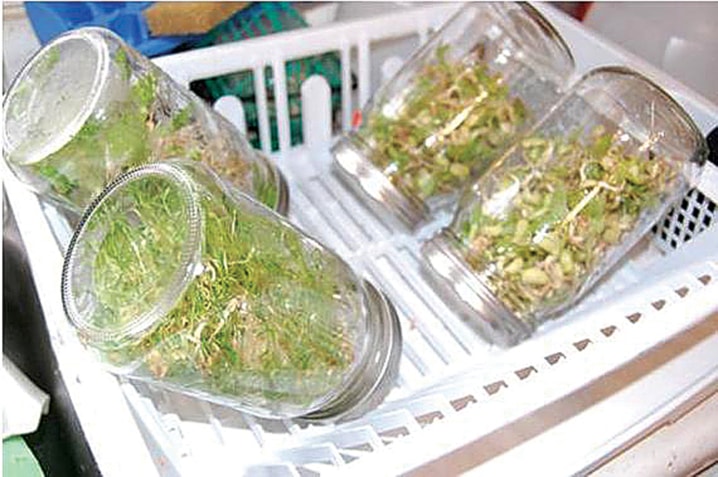The produce sections overflow with products all year.
While they are ‘fresh’ they do not have that just picked taste. Produce that has been kept in special storage units break down quickly once they are placed in a warm-store environment. Many items have been shipped from other continents and have undergone a few processes to ensure that they are still saleable when they arrive at the stores.
It is possible to purchase tomatoes, peppers and cucumbers that are grown in local greenhouses. Be prepared to pay a slightly higher price for tastier, fresher, locally grown produce. The cost reflects the growers cost in labour and heating.
For those that crave fresh greens, purchase seed and grow sprouts. It takes three to five days for the seeds to germinate and become large enough to eat. The procedure is relatively easy and takes up very little room.
To germinate, the seeds must have moisture and warmth. The seeds either have to have a continuous source of moisture or be rinsed with water two to three times a day.
Mason jars are easily available and work well if the metal disk in the lid is replaced by a screen or a loosely woven piece of cloth.
Place a heaping tablespoon of seed in the jar and place the lid on top. Rinse the seed with warm water making sure to drain out all excess moisture. Repeat this procedure two or three times a day until the seeds have sprouted and are ready to eat.
It is also possible to sprout seeds using a paper towel, plate and plastic bag. Wet the towel and put it on the plate. Sprinkle the seed on the paper towel and seal it into a plastic bag. If the bag becomes saturated with moisture open it to allow excess moisture to escape. Too much moisture will cause the seeds to mould.
If the bag has no condensation and the paper towel is becoming dry, mist it with warm water and place the plate back into the bag.
Bags made out of cotton or hemp are also used to sprout seeds. The seeds are placed in the bag and the bag is dipped into warm water and hung up to drip and dry. This is repeated three or four times a day.
When using manufactured sprouters, follow the instructions provided.
Sprouting seeds for consumption is a delicate balance of providing enough moisture for the seed to germinate but not enough for the seeds to rot or mould. Never leave seed sit in water for an extended period of time. Sanitize the sprouter between uses especially if mould and mildew have been a problem in the past.
Once the seeds have geminated and grown to the desired size, remove them from the sprouter. Discard any product that is not fresh. Once the sprouts are dry to the touch they should be placed in a sealed container and stored in the refrigerator until they are used.
The shelf life is limited so eat quickly.
Sprouting seed can be purchased at grocery or health food stores. Garden seeds can be eaten as sprouts if it hasn’t been treated with chemicals.
The taste of the sprout varies with the seed. The most common to find and easiest seeds to sprout are: Chia, alfalfa and mung beans.
These are relatively bland while radish, cress and mustard are spicy to hot. Sprouts can be eaten straight, added to salads, sandwiches and smoothies.
Linda Tomlinson is a horticulturalist that lives near Rocky Mountain House. She can be reached at www.igardencanada.com or your_garden@hotmail.com
